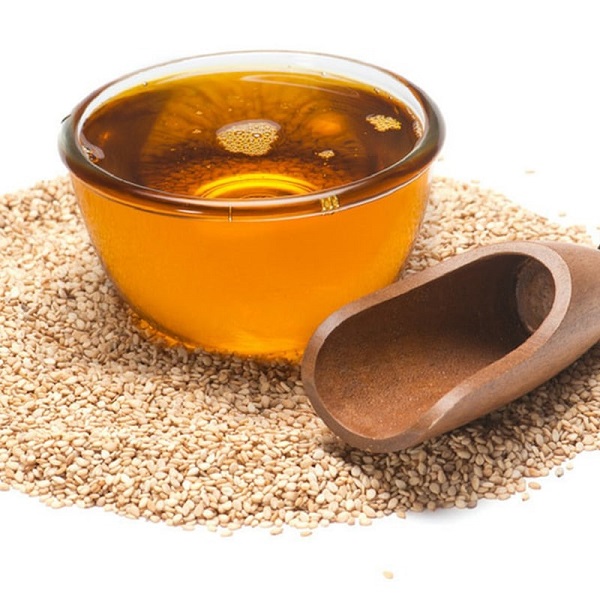Do you ever find yourself standing in the grocery store aisle, staring at two seemingly identical bottles of oil and wondering which one to choose? If you’ve been faced with toasted sesame oil and regular sesame oil, then this blog post is for you! While both oils come from the same plant, they have distinct flavor profiles and are used differently in cooking. So let’s dive into the world of sesame oil and explore their differences!

Table of Contents
Introduction to Sesame Oil
Sesame oil is a type of vegetable oil that’s extracted from sesame seeds. It’s popular in Asian cuisine and can be used for stir-frying, marinating, and as a condiment.
There are two types of sesame oil: toasted and untoasted. Toasted sesame oil has a nutty flavor and is used as a finishing oil, while untoasted sesame oil has a milder flavor and is used for cooking.
So, what’s the difference between toasted and untoasted sesame oil? Toasted sesame oil is made by heating the seeds until they turn brown, which brings out the nutty flavor. Untoasted sesame oil is made without heating the seeds, so it has a lighter flavor.
Uses of Toasted Sesame Oil and Sesame Oil
Toasted sesame oil has a deep, nutty flavor that is perfect for stir-frying and marinades. Sesame oil, on the other hand, has a lighter flavor and is ideal for dressings and dipping sauces. Here are some recipes that showcase the different uses of toasted sesame oil and sesame oil:
- Stir-Fried Noodles with Toasted Sesame Oil: This dish is packed with flavor thanks to the toasted sesame oil. The noodles are stir-fried with vegetables and a protein of your choice, making it a complete meal.
- Sesame Chicken Salad: This salad gets its zing from sesame oil, which is used in the dressing. The salad is full of healthy ingredients like chicken, cabbage, and carrots, making it a great option for a light lunch or dinner.
- Toasted Sesame Rice: This rice dish is flavored with toasted sesame oil and can be served as a side or main course. It’s simple to make and can be easily customized with your favorite ingredients.
- Sesame Dipping Sauce: This sauce is made with sesame oil and soy sauce, and it’s the perfect accompaniment to any Asian-inspired meal.
If you’re a fan of Asian cuisine, then you’re probably familiar with toasted sesame oil and sesame oil. Both of these oils are made from sesame seeds, but they differ in terms of taste, smell, and overall cooking properties.
Toasted sesame oil has a nutty, slightly smoky flavor that is perfect for stir-fries, marinades, and dressings. It’s also a common ingredient in Korean and Chinese dishes. On the other hand, sesame oil has a more neutral flavor and can be used for frying, sautéing, or as a finishing oil.
So which one should you use? It really depends on what you’re making and your personal preferences. If you want an intense flavor boost, go with toasted sesame oil. But if you want a more versatile oil that can be used in multiple ways, stick with regular sesame oil.
Differences Between Toasted Sesame Oil vs. Sesame Oil
Toasted sesame oil and sesame oil both have a nutty flavor and can be used in many international dishes. The main difference between the two is that toasted sesame oil is made from roasted sesame seeds while regular sesame oil is made from raw, unhulled seeds. Toasted sesame oil has a darker color and a stronger flavor than regular sesame oil. It is also more expensive and harder to find in stores.
Read more:
The Truth About Convection Vs Toaster Ovens: How the Latter Wins Every Time
Toaster Oven Vs Air Fryer: Which Is More Versatile in The Kitchen?
Health Benefits of Toasted Sesame Oil and Sesame Oil
Toasted sesame oil and sesame oil both offer a variety of health benefits. Toasted sesame oil is a good source of antioxidants, which can help protect the body from damage caused by free radicals. Sesame oil is also a good source of anti-inflammatory compounds, which can help to reduce inflammation throughout the body.
Toasted sesame oil is also a good source of vitamin E, which is known for its ability to help improve skin health and protect against wrinkles. Sesame oil can also help to improve heart health by helping to lower cholesterol levels and reduce the risk of heart disease.
How to Use Toasted Sesame Oil and Sesame Oil in Food Preparation
When it comes to cooking with sesame oil, there are really two different types that you can choose from toasted sesame oil and regular sesame oil. Toasted sesame oil has a more intense flavor since the seeds are actually roasted before they’re pressed to extract the oil. This makes it ideal for using in stir-fries or other dishes where you want a bolder taste. It can also be used as a finishing oil, added at the end of cooking to give your dish an extra boost of flavor. Regular sesame oil, on the other hand, is made from raw seeds that are simply pressed to extract the oil. It has a milder flavor and is usually used as a base for dressings or marinades. It can also be used for cooking, but since it has a lower smoke point than toasted sesame oil, it’s best to use it for dishes that don’t require high heat.
Common Recipes with Toasted Sesame Oil and/or Sesame Oil
Toasted sesame oil is a type of oil that is made from toasting sesame seeds. The toasting process brings out the nutty flavor of the sesame seeds and gives the oil a dark color. Sesame oil, on the other hand, is made from raw sesame seeds and has a lighter color and milder flavor.
Both toasted sesame oil and sesame oil can be used in cooking. Toasted sesame oil is often used as a finishing oil, meaning it is added at the end of cooking to enhance the flavor of a dish. It can also be used for sautéing or stir-frying. Sesame oil, on the other hand, can be used in all stages of cooking. It is often used as a base for curries or stir-fries.
Here are some common recipes that use toasted sesame oil and/or sesame oil:
- Sautéed greens with toasted sesame oil: This simple recipe uses toasted sesame oil to give sautéed greens an extra boost of flavor.
- Stir-fried rice with sesame oil: This classic Chinese dish uses both toasted sesame oil and sesame oil to create a fragrant and flavorful dish.
- Curry chicken with coconut milk and sesame oil: This rich and creamy curry uses both toasted sesame oil and sesame.

FAQs
How long does sesame oil last?
If you’re like most people, you probably have a bottle of sesame oil in your pantry that’s been there for who knows how long. And while sesame oil does have a relatively long shelf life, it will eventually go bad. So how can you tell if your sesame oil is still good?
The first thing to look for is a change in color. Sesame oil should be a deep golden color. If it has started to turn light brown or has any streaks of white, then it’s time to toss it out.
Another way to tell if sesame oil has gone bad is by smell. Good sesame oil should have a nutty, slightly sweet aroma. If the oil smells rancid or off, then it’s no longer good to use.
If you’re not sure whether your sesame oil is still good, err on the side of caution and throw it out. It’s better to be safe than sorry when it comes to food safety!
When it comes to sesame oil, there are two types: toasted and untoasted. Toasted sesame oil is made from roasted sesame seeds and has a deep, nutty flavor. It’s often used as a finishing oil or for stir-frying. Untoasted sesame oil, on the other hand, is made from raw sesame seeds and has a lighter flavor. It’s often used as a base for dressings or marinades.
So how long does each type of sesame oil last? Toasted sesame oil will last for about 6 months before it starts to go rancid. Untoasted sesame oil will last for up to 1 year before it starts to go bad.
Read more: How Long Does Coconut Flour Last? Extending the Shelf Life of Coconut Flour
Does sesame oil need to be refrigerated?
Sesame oil does not need to be refrigerated, but it can help to extend its shelf life. If you store sesame oil in a cool, dark place, it can last for up to a year. However, if you live in a warm climate or keep your kitchen very warm, you may want to refrigerate your sesame oil to ensure that it doesn’t go rancid.
Conclusion
All in all, the main difference between toasted sesame oil and regular sesame oil is their flavor profiles. Toasted sesame oil offers a richer, nuttier flavor for those looking for a deeper taste profile while regular sesame oil will lend its sweet subtlety to any dish. As always, use whichever suits your individual tastes or needs best; both types of oils can definitely add depth and complexity to any dish they are used in.
References:
https://www.simplyrecipes.com/your-guide-to-untoasted-sesame-oil-5202999
https://www.masterclass.com/articles/how-to-toast-sesame-oil








